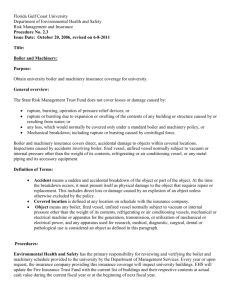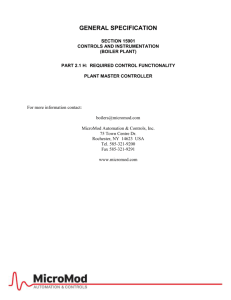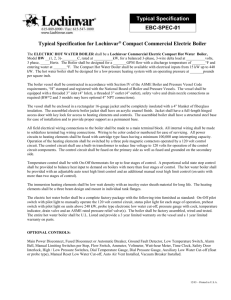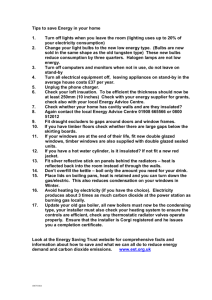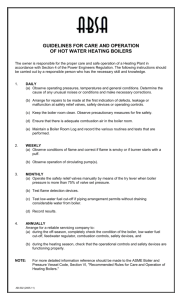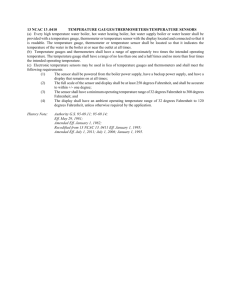Fire Brick - Firebrick arranged suitable for oil burning.
advertisement
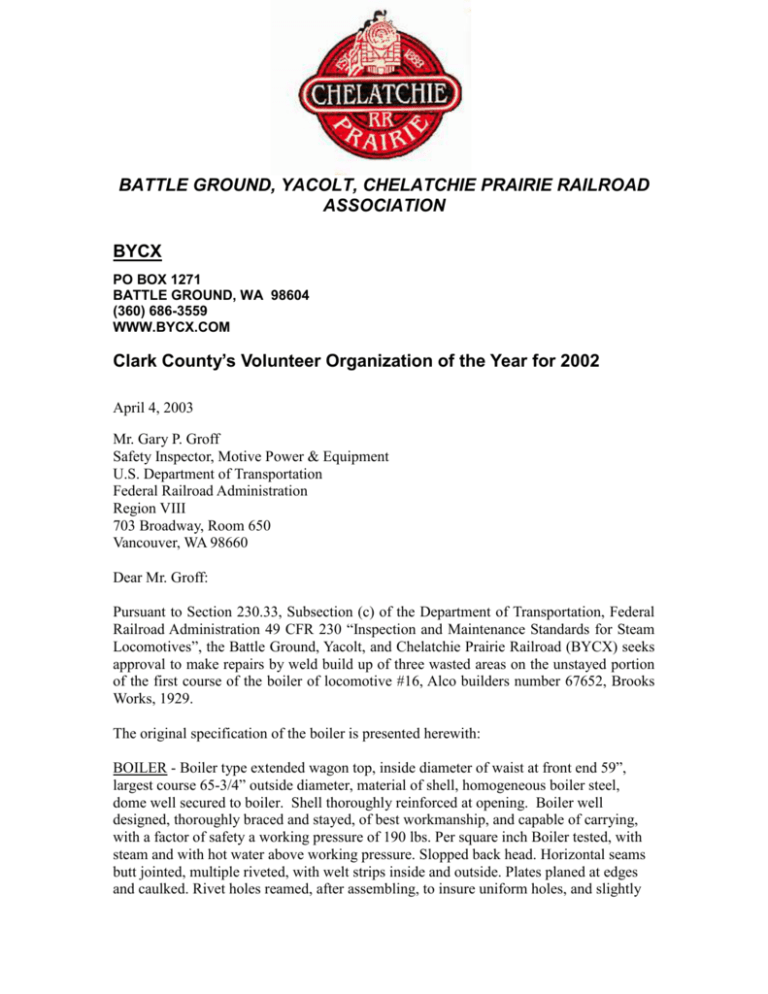
BATTLE GROUND, YACOLT, CHELATCHIE PRAIRIE RAILROAD ASSOCIATION BYCX PO BOX 1271 BATTLE GROUND, WA 98604 (360) 686-3559 WWW.BYCX.COM Clark County’s Volunteer Organization of the Year for 2002 April 4, 2003 Mr. Gary P. Groff Safety Inspector, Motive Power & Equipment U.S. Department of Transportation Federal Railroad Administration Region VIII 703 Broadway, Room 650 Vancouver, WA 98660 Dear Mr. Groff: Pursuant to Section 230.33, Subsection (c) of the Department of Transportation, Federal Railroad Administration 49 CFR 230 “Inspection and Maintenance Standards for Steam Locomotives”, the Battle Ground, Yacolt, and Chelatchie Prairie Railroad (BYCX) seeks approval to make repairs by weld build up of three wasted areas on the unstayed portion of the first course of the boiler of locomotive #16, Alco builders number 67652, Brooks Works, 1929. The original specification of the boiler is presented herewith: BOILER - Boiler type extended wagon top, inside diameter of waist at front end 59”, largest course 65-3/4” outside diameter, material of shell, homogeneous boiler steel, dome well secured to boiler. Shell thoroughly reinforced at opening. Boiler well designed, thoroughly braced and stayed, of best workmanship, and capable of carrying, with a factor of safety a working pressure of 190 lbs. Per square inch Boiler tested, with steam and with hot water above working pressure. Slopped back head. Horizontal seams butt jointed, multiple riveted, with welt strips inside and outside. Plates planed at edges and caulked. Rivet holes reamed, after assembling, to insure uniform holes, and slightly counter-sunk under head of rivets, Boiler built to ASME Boiler Code Part 1, Section 3 Engine to operating in State of Oregon. Fire Box - Fire box of homogenous fire box steel, Length inside 90-1/8”, width inside 401/4”. Thickness of crown sheet 3/8”, tube sheet 1/2”, sides 3/8”, back, 3/8”. Water space front 4”, sides 3-1/2”, back 3-1/2”. Mud Ring - Mud ring accurately fitted and substantially double riveted. Cast steel in 1 piece. Staybolts - of wrought iron, 1” diameter, screwed and riveted to sheets, suitably spaced from center to center, and pneumatically driven. Tell tale holes drilled in outer ends. Crown sheet supported by radial stays of wrought iron 13/16” diameter body, 1” ends. Body of ample diameter, with enlarged ends, screwed through the crown and shell and riveted over. Suitable number of front transverse rows to be expansion stays. Superheater - The Superheater Co.’s firetube type “A” superheater. Tubes - Tubes of seamless shell #15 R.W.G. thick (min) 112 in number, 2” outside diameter 12’6” long, set with copper ferrules at firebox end, 11/16” tube spaces. 21 Superheater flues of seamless shell 5-3/8” OD #10 BWG thick (min). Fire Brick - Firebrick arranged suitable for oil burning. Cleaning Holes - Washout plugs provided at corners of firebox, above fire door and crown sheet, and for washing shell of boiler. Blow-off Cock – one Builders standard Safety Valves - Two open pops. Water Supply - Furnished by two lifting injectors Nathan Monitor and Hancock Inspirator. Oil Burner - Oil burning arrangement and burner of Southern Pacific design. Pan - pan of steel plate Smoke box - Smoke box extended and arranged suitable for oil burning. Front end door of pressed steel, carefully fitted. Smoke Stack - Smoke stack of cast iron, designed to give maximum draft. Inspection of the boiler for preparation of the FRA Form 4 found the exterior of the boiler to have corrosion in areas originally covered by asbestos insulation. Areas that had not been covered by the insulation and the interior of the boiler were found to be in remarkably good condition. The first and second courses of the boiler are of low carbon steel, the original thickness was 0.625”. The firebox is constructed of low carbon steel and was found as described in the specification, the thickness of crown sheet 0.375”, tube sheet 0.500”, sides 0.375”, back, 0.375”. Some areas of the firebox had been repaired by welding, these areas were examined by shear wave ultrasound by Kenny Greene of Canyon Inspection Service, Riverside, CA. Defects were found in the welds in the side sheet of the firebox on the engineers side of the locomotive. Repairs were made by B.W. Garren of the C. H. Murphy Company of Portland, Oregon. After the repairs were complete Kenny Greene repeated the shear wave ultrasound examination and provided documentation that the welds were free from defects. Alco practice documents for the period when this locomotive was constructed specify low carbon steel with a tensile strength of plate of 55,000 lbs. Samples have been sent BodyCote Materials Testing, 4949 SE Johnson Creek Blvd., Portland, Oregon to determine actual carbon content, 50,000 lbs tensile strength is being used for boiler calculations. Plate thickness for the entire boiler was determined by ultrasound techniques, using a StressTel T-Mike E, serial number 00X32M, last calibrated 24 January 2003. A 1-foot grid pattern was used. Where surface roughness made reliable measurements difficult on the exterior of the boiler measurements were made from the interior of the boiler. The steel surface of the boiler was found to be in a remarkably smooth condition. Additional measurements were made if surfaces conditions suggested the possibility of a wasted area. Measurements indicated the boiler and firebox to have a sheet thickness greater than 60% of original material, only three areas were found with thickness less than 90% (0.5625”), all on the first course. The largest wasted area measuring about 3 inches in diameter having a thickness of 0.403”. Two smaller wasted areas were found, one measuring less that 1 inch in diameter having a thickness of 0.398” and a third area about 1 inch square with a thickness of 0.473”, even though the area is greater than 75% of original thickness the operators of the locomotive decided that any area less than 90% would be built up by welding. Individual(s) qualified to perform welds on pressure vessels will build up these areas in accordance with accepted national standards. Procedure for welding: The areas to be welded will be cleaned and ground to good metal. The area to be welded will be dye penetrant checked for cracks, then cleaned. The area will then be preheated to 300 degrees using the alternate method. Welds will be made with 7018 rod. Temperatures will be maintained at no more than 450 degrees in the area being welded. The welded area will be allowed to cool. The welded area will be dry penetrant check for cracks After the welded repairs are complete all sections of the boiler and firebox will be 90% or greater than original thickness. Attached as exhibits 1, 2 and 3 are mechanical drawings of the cross section of the boiler and photographs that illustrate the wasted areas. Exhibit 4 illustrates the boiler and shows the location of the proposed repairs. Respectfully submitted, Leighton M. Reed-Nickerson Chief Mechanical Officer Exhibit 1: Drawing and photograph of 3” circular wasted area, First Course BYCX 16 Exhibit 2: Drawing and photograph of 1” circular wasted area, First Course, BYCX 16 Exhibit 3: Drawing and photograph of 1” square wasted area, First Course BYCX 16 Exhibit 4: Drawing boiler BYCX 16 showing location of wasted areas.

